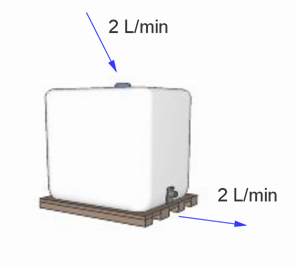Section 10.2 Some Simple Applications of First Order Separable DEs
Example 10.2.1.
Find a curve in the \(xy\)-plane that passes through the point \((0,3)\) and whose tangent line at any point \((x,y)\) has its slope given by \(\frac{2x}{y^2}\text{.}\)
Answer.\(y(x)=(3x^2+27)^{1/3}\)
Let the curve be \(y(x)\text{.}\) Then we know
i.e. \(y\) is the solution to an initial-value problem involving a first order separable DE. From the DE, we obtain
and hence
Using the initial condition gives \(C=9\) and hence the required curve is
Example 10.2.2.
Suppose that the temperature a cup of coffee when it is poured is \(95^oC\text{.}\) The cup is left to stand in a room where the temperature is \(20^oC\text{.}\) If the temperature of the coffee is \(90^oC\) after \(2\) min, how long will it take for the temperature of the coffee in the cup to reach \(25^oC\) according to Newton’s law of cooling?
Answer.\(t\approx 78.5 \textrm{ min}\)
Let \(T(t)\) be the temperature of the cup of coffee at time \(t\) min after it was poured and let \(T_a\) be the room (ambient) temperature. Now, Newton’s law of cooling says that the rate at which the temperature of an object falls is proportional to the difference in the temperature of the object and the temperature of its surroundings. Thus
where \(k\gt 0\) is the constant of proportionality. This is a first order separable DE and on separating the variables and integrating both sides with respect to \(t\) we get
Evaluating the integrals gives
and hence
Thus, according to Newton's law of cooling the coffee will have cooled to \(25^oC\) at the value of \(t\) satisfying
from which we find
Example 10.2.3.
Consider a \(100\)L tank which contains pure water. At time \(t=0\) salt water begins to flow into the tank at a rate of \(2\)L/min and the mixed water flows out of the tank at the same rate. If the concentration of the salt in the inflowing water is \(35\)g/L determine the concentration, \(C(t)\text{,}\) of the salt in the tank as a function of time. 
\(C(t)=35-35e^{-t/50}\)
Let \(A(t)\) be the amount of salt in the tank (in grams) at time \(t\text{.}\) Then, since there is \(100\)L of water in the tank
Now, since the water in the tank is initially pure, we have the initial condition \(A(0)=0\) or equivalently \(C(0)=0\text{.}\) Finally, the rate at which the amount of salt in the tank is changing is given by the difference of the rate at which the amount of salt is increasing (due to the salt water entering the tank) and the rate at which the amount is decreasing (due to the mixed water flowing out). Since salt water is entering the tank at a rate of \(2\)L/min and each litre contains \(35\)g of salt, the rate at which the amount of salt is increasing is \(70\)g/min. Since the mixed water is flowing out of the tank at the rate of \(2\)L/min and each litre contains \(C(t)\)g the rate at which the amount of salt is decreasing is \(2C\)g/min. Thus
From (10.2.1),
Putting (10.2.3) into (10.2.2),
which is a first order separable DE. Separating the variables and integrating both sides with respect \(t\) gives
Evaluating the integrals gives
and hence
Using the initial condition \(C(0)=0\) gives \(k=35\) and hence
Exercises Example Tasks
1.
An ingot of gold is placed into a furnace which has a temperature of \(1200^oC\text{.}\) After \(3\) min the temperature of the ingot has risen from \(40^oC\) to \(610^oC\text{.}\) Assuming Newton's Law of Cooling how long before the ingot reaches the melting temperature of \(1064^oC\text{?}\)
2.
Consider a \(50\)L tank which contains salt water with concentration of \(20\)g/L. At time \(t=0\) more salt water begins to flow into the tank at the rate of \(3\)L/min and the mixed water flows out of the tank at the same rate. Assuming that the concentration of salt in the inflowing water is \(30\)g/L how long will it take for the concentration of the water in the tank to reach \(25\)g/L?